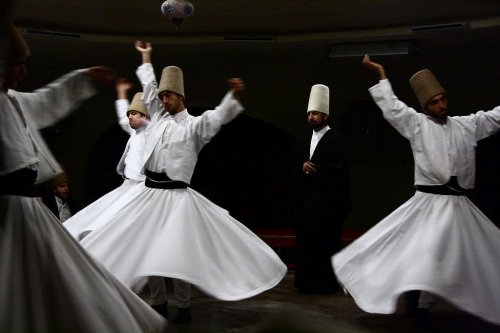
|   |

|   |
 e-mail: arshiyasethi@gmail.com What we need to remember on World Dance Day May 10, 2019 This column was meant to be written for World Dance Day, but foreign travels took priority and I decided that just so much happens around and on World Dance Day, that the delay will probably be welcome to a mind already buzzing with dance overload as happens on World Dance Day. World Dance Day is more than a celebration of dance. It is an acknowledgement of the important role dance plays as a language of human expression. It also recognises the way dance benefits us all by way of mental and physical well being. In fact, the healing capacity of dance has long been recognised in India, and that is why it is called a Yoga, but around the world today this truth is being acknowledged and respected. World Dance Day also has a political underpinning. It is a day we acknowledge that dance is not permitted, in fact it is declared illegal in many countries in the world. In some countries and societies certain groups, separated on religious lines, gender cohorts and social stratifications, are denied the right to dance. Dancing bans are also imposed on certain days and at certain times and places. You would be surprised to know just how many countries in the world have illegalised dance, and this is not only about sexually suggestive forms of dancing like topless, lap, cabaret and erotic dancing. While these forms of dancing may have legal implications around "decency laws", Rave dancing is also viewed through the lens of suspicion by law enforcement since it is associated with substance use, especially the use of a drug called Ecstasy of MDMA- both known as "party drugs". There is some merit in challenging drug use, since both these drugs are highly addictive and are known to cause sudden death. In progressive Germany and Switzerland, dancing on some holidays is banned by most state and canton governments on certain days associated with mourning or contemplation. These are not just Christian holidays like Good Friday and All Saints Day but also secular holidays like the German holiday of Volkstrauertag, that commenced from 1952 and which commemorates fallen members of the armed forces and civilians who died in conflicts, and includes victims of violent oppression. It was first observed in its modern form in 1952. While upholding the right to privacy this ban extends to public spaces only leaving private spaces like your home free from the ban. Many Christian communities believe that dancing is either inherently sinful or that certain forms of dancing could lead to sinful thoughts or activities, and thus proscribe it either in general or during religious services. Among these are Mennonites, Hutterites, Baptists, Seventh Day Adventists and Holiness Movement sects. At the same time, sects like the Charismatic Christians that believe in the work of the Holy Spirit, and Pentecostal Christians that together numbered over 584 million or a quarter of the world's 2 billion Christians in 2011, embrace dance.  Footloose You would find it hard to believe that in the United States of America, several municipal and city laws banned certain types of dancing, for certain types of people For instance, until 1999, an ordinance in Pound, Virginia, required that dance hall permits not be granted "to anyone who is not a proper person, nor to a person who is not a person of good moral character." Community opposition, fructified in the ordinance being struck down as unconstitutional, for infringing on free expression protected by the First Amendment. Since 1926 to as recently as 2017, the New York City Cabaret law has prohibited dancing in all spaces open to the public that sell food and/or drink with the exception of those who obtain a specific cabaret license. Between 1985 and 2002, a law that operated in Seattle, Washington, called the Teen Dance ordinance, and often referred to as draconian, enacted to restrict dancing by youth under the age of 21. While the reason cited for promoting the ban had to do with fears of child abuse and prostitution, and drug and alcohol abuse it succeeded in effectively banning events that would feature young people dancing. In fact even the 1984 movie 'Footloose,' situated in the fictional town of Bomont, Oklahoma, was in fact loosely based on a real incident in the town of Elmore City, Oklahoma. This town had banned dancing since its founding in 1898 in an attempt to decrease the amount of heavy drinking. One advocate of the dancing ban was the Reverend F.R. Johnson from the neighbouring town of Hennepin. He believed that "No good has ever come from a dance" convinced that it leads to only two things - women and booze. Because of the ban on dancing, the town never held a prom. In February 1980, the junior class of Elmore City's high school made national news when they requested permission to hold a junior prom and it was granted. The request to overturn the ban in order to hold the prom was met with a 2-2 decision from the school board. The then school board president Raymond Lee broke the tie with the words, "Let 'em dance." This story then inspired the film 'Footloose' which went in to receive a 1985 Golden Globe Award nomination for Best Original Song - Motion Picture, a Broadway Musical in 1998 and a film remake in 2011.  Attan from Afghanistan Source: Wiki Commons Yet, if asked to guess, most people would guess Islamic nations among those that ban dance. They would not be entirely wrong. Dance became a casualty of the war in Afghanistan. Once known for its ancient folk dance called Attan, replete with acrobatic whirling and head movements accompanying strong drum beats, that was performed on all happy occasions like weddings and engagements under the Taliban regime in Afghanistan, it, along with all forms of dance were banned. In 2012, Taliban insurgents beheaded 17 revellers at a party in southern Afghanistan, due to the fact that they were listening to music and dancing. It was a very special occasion when in January 2017, a group of Attan dancers from Afghanistan, that included a woman musician as well, performed in Hyderabad on a stage offered by the inaugural Asian Broadcasting Union's Television Dance Festival, and which was telecast internationally. The condition in Iran is even more distressing. In 2014, a group of young Iranian boys and girls were arrested for dancing to Pharrell William's upbeat, bestselling and Grammy award winning song, "Happy". Happiness, rather than the right to dance became the point over which the hardliners and the soft-liner in government argued. Despite that brouhaha, later the same year, an Iranian woman protested against Iran's strict laws by dancing publicly on the Tehran metro (video below). Risking arrest by Iran's modesty police, many more danced on streets and in public places as they resisted Iran's strict misogynist laws by increasing the visibility of their disruptive act through posting videos on social media. In July 2018, Iranian teenager Maedeh Hojabri was arrested, for recording dance videos in her bedroom and uploading them to her Instagram account. An additional charge on her was that she appeared in these videos without a head scarf. She was not the only one to do so and meet this fate. It is believed that three others too were arrested for the same reason. State TV in Iran broadcast a video in which Hojabri acknowledged breaking moral norms while insisting that it was not her intention, as she was only trying to gain more followers. It is possible that the teen dancer made this statement under duress. It resulted in a spate of such videos popping up in protest, leading the government to seriously consider banning these sites. Presently Maedeh Hojabri is on bail. Kuwait also takes a strict view toward dancing in public, with detailed rules when it comes even to music concert behaviour. Perish the thought of head-banging, that all of us seem to take for granted, in Kuwait, movements, beyond clapping one's hands and swaying slightly, are all disallowed. Critics say the law is a symptom of the tightening grip of hardline Islamism, unreflective of the country's past, an argument that holds true even in the case of Afghanistan. After all, it was in the Afghan city of Balkh that Rumi was born, and it was Rumi who encouraged the Sufi dervish practice of whirling!  Whirling Dervishes Source: Wiki Commons At the Toronto International Film Festival in 2018, I saw a film 'When Arabs Dance' by director Jawad Rhalib that has been described by critics as "a celebration of artistic freedom and beauty and a provocation." Morocco born Jawad is a veteran of over twenty documentaries. 'When Arabs Dance' is his twenty-second documentary, and certainly a timely one. It is daring, since he himself described it as "an alarm signal...(against) increasingly violent Islamist threat." Shot over Egypt, Morocco, Belgium, France, and Iran, using artistes "who resist and refuse to remain silent" it also contained archival footage that flew in the face of the conservatives and was "a sensual ode to Arab Muslim culture and freedom" that was honoured as the norm many decades ago. The subtext of the film, that expands its purview from personal essay to cultural investigation, was the threat to those in these countries who continued to defy and dance. So, on this World dance Day, let us spare a thought for all those who are not allowed to dance, not allowed to be themselves, speak the most natural language that they know, and have to bear humiliation, indignity, personal restrictions and violence, as they do what they love to do. The next time you dance, or see and enjoy dance, let us thank not only our enablers but also remember those who are shackled by fear and cannot have this simple pleasure.  Dr. Arshiya Sethi, trained in Kathak, has served as dance critic, commentator, institution builder for the arts, having created both tangible and intangible institutions and equities. She has been a Fulbright Arts Fellow (2003-2004) and a post doctoral Fulbright (2016-2017). Her doctoral work has been on the link between politics and dance in the case of Sattriya. She is presently working on the intersection of dance and activism / social justice as well as Indian dance in the diaspora. Post your comments Please provide your name and email id when you use the Anonymous profile in the blog to post a comment. All appropriate comments posted with name & email id in the blog will also be featured in the site. |